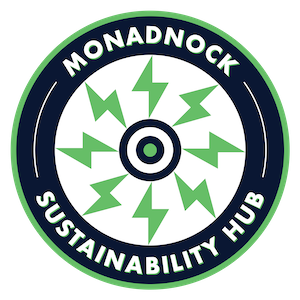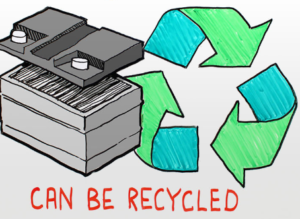by Ann Shedd, MSH Co-chair.
Originally Published in The Monadnock Shopper News, Green Monadnock column, April, 2023. Fifty-three years after the first Earth Day, April still brings our attention back to the Reduce-Reuse-Recycle guidelines. All three are important measures! When reducing or reusing materials isn’t possible, most of us have a good sense of how to recycle our paper, glass, aluminum, steel, and plastic – although the EPA estimates that 75% of American waste is recyclable and we only recycle about 30% of it.
What about all the batteries we go through in a lifetime, in our cars and cell phones, computers, small electronics, toys and more? Many modern batteries are rechargeable, but at some point most batteries do reach a “point of no recharge.” What then? Our local transfer stations and some retail stores offer collection of various battery types for recycling. A Google search may help you find which facilities accept which battery types.
Car batteries call for special handling. Conventional gas-powered vehicles have long used Lead-Acid batteries containing lead sulfate and sulfuric acid. Since the 1930s there have been processes to retrieve the lead in these batteries, at significantly less cost than mining “new” lead. The operations to achieve this were a free-for-all for almost half a century, and there are still lead-contaminated sites around the US due to improper handling of the lead. In the 1980s, bipartisan measures were developed to clean up the battery-recycling industry. Currently more than 90% of Lead-Acid batteries are recycled, with recovered materials used to manufacture new batteries. This is a fine example of what is termed “the Circular Economy.”
A circular economy keeps materials and products in circulation for as long as possible, maintaining their value for as long as possible and minimizing waste. Doesn’t that sound like a good idea?? It is a concept already being applied to manufacturing sectors as diverse as paper, clothing and other textiles, furniture, solar panels – and car batteries.
Unlike gas-fuelled vehicles with Lead-Acid batteries, electric vehicles (EVs) are powered entirely by Lithium-Ion batteries. Compared to Lead-Acid batteries, these batteries store more energy for a longer time and use the energy more efficiently. After 10-15 years these batteries may no longer hold a road-worthy charge, but they can be reconditioned for large-scale or smaller stationary energy storage. (This should not be tackled as a DIY project!) At some point in the batteries’ life even this re-use reaches its limit and it’s time to recycle the batteries.
The number of EVs on US roads is forecast to be over 25 million by 2030. How will all these batteries be recycled? The good news is that the metals in Lithium-Ion batteries from EVs – and our many and various electronics – are already being reclaimed and reused. There are multiple businesses in this growing sector in the US. A Massachusetts company has opened a battery-recycling plant in Georgia and a Nevada company is building a second large battery-recycling plant in South Carolina. Both will “mine” materials from batteries from EVS and consumer electronics, to be used in the manufacture of new batteries. They will also process waste materials from battery-manufacturing facilities in the Southeast and elsewhere; this is another beneficial aspect of the Circular Economy. The 2022 Inflation Reduction Act includes incentives for EV manufacturers to source battery materials in the US or from free-trade partners and to build EV batteries in North America. Moving the supply-chain on-shore is “fueling” significant domestic job growth: just the one new South Carolina plant will create 1500 jobs.
Analyses suggest that by 2040, the materials recovered from used batteries could provide more than half of the materials needed for increased Lithium-Ion battery demand. Many people logically ask where the rest of the minerals will come from. There are valid concerns about the human and environmental impact of current practices in mining Lithium, Cobalt, and other materials used in batteries. (There are likewise valid concerns about the impacts of many materials and fuels that currently power our lives.) Future Green Monadnock columns may discuss some of these concerns.
Other exciting US frontiers in the Circular Economy: companies are recycling 90% of materials from solar panels and fiberglass and other materials from wind turbines. Watch the clean energy economy roll!
Ann Shedd is a retired physician, a former member of the City of Keene’s Conservation Commission and Energy and Climate Committee, a current member of the Board of the Monadnock Sustainability Hub, and an enthusiastic recycler.

